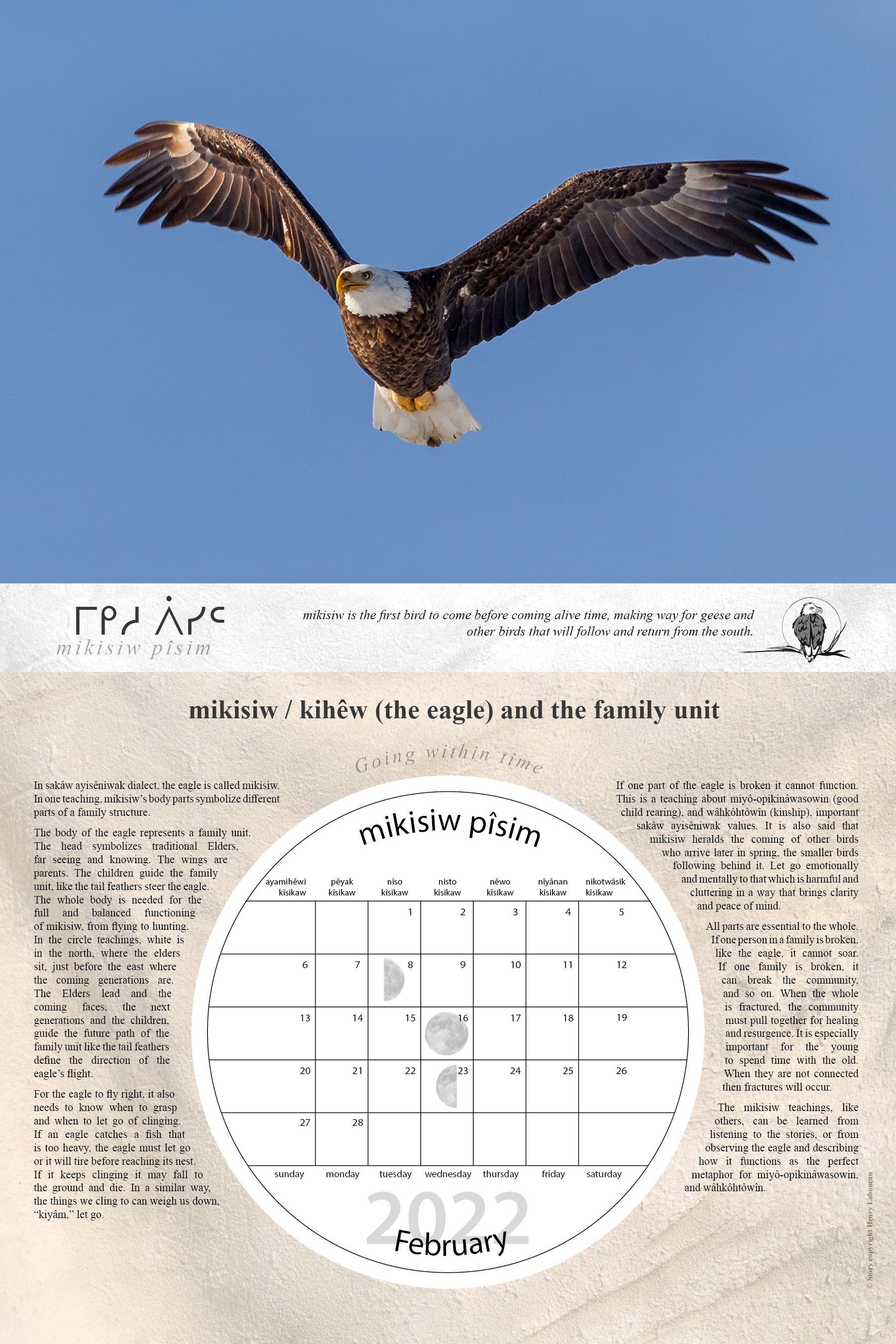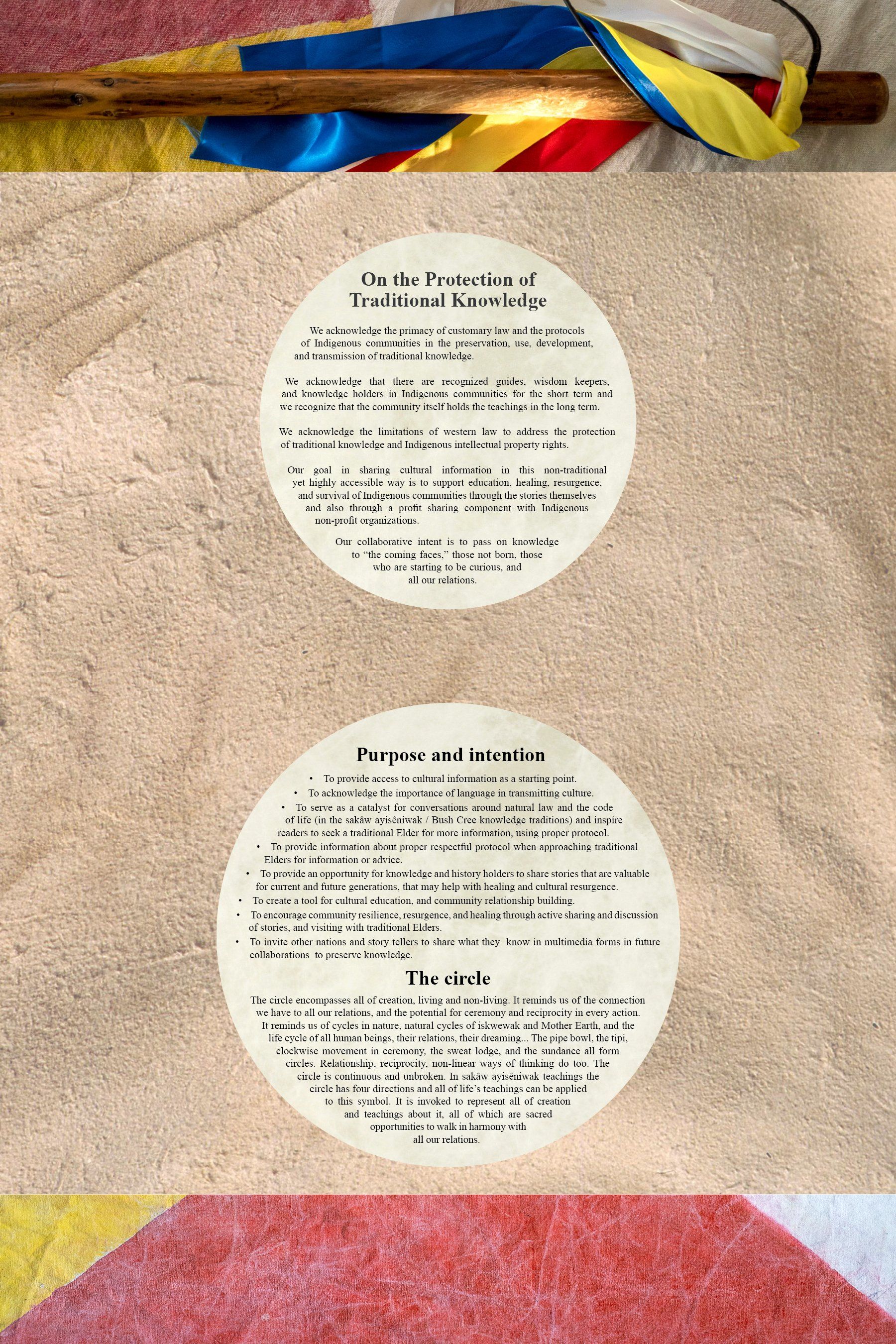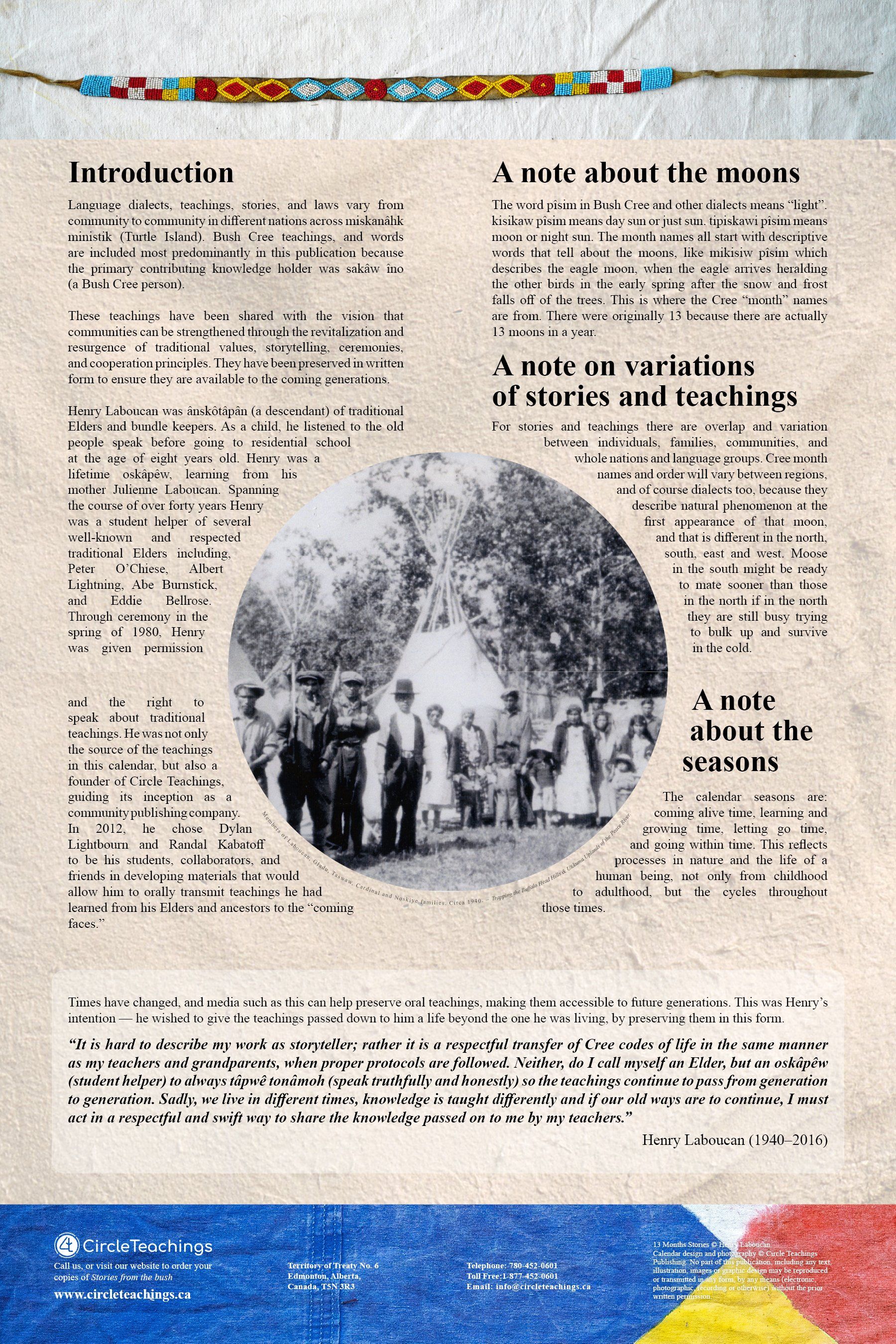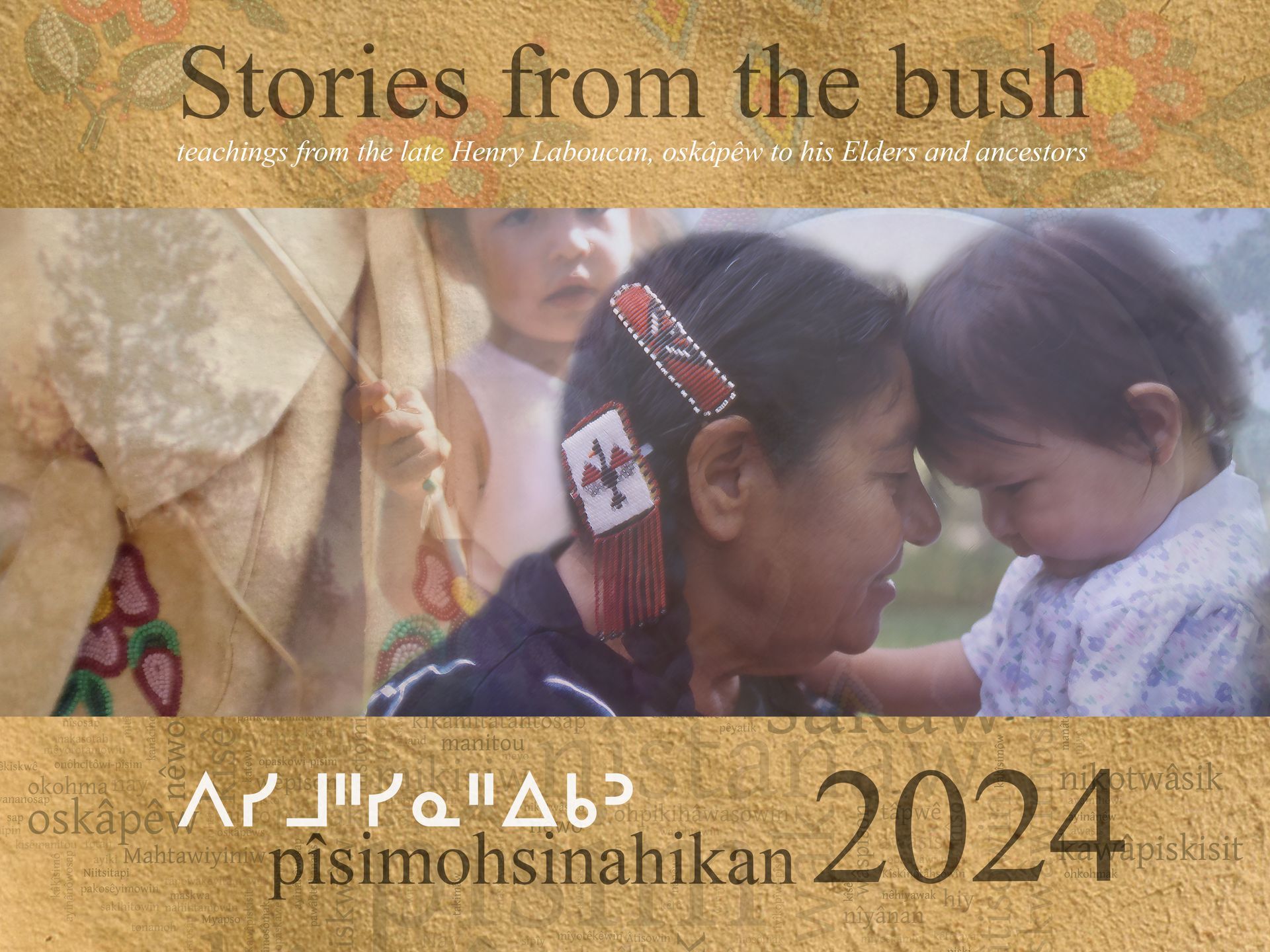STORIES FROM THE BUSH
Language dialects, teachings, stories, and laws vary from community to community in different nations across miskanâhk ministik, Turtle Island. Bush Cree teachings and words are included most predominantly in this publication, because the knowledge holder who shared their teachings is sakâw îno, a Bush Cree person.
These teachings have been shared with the vision that communities can be strengthened through the revitalization and resurgence of traditional values, storytelling, ceremonies, and cooperation principles. They have been preserved in written form to ensure they are available to the coming generations.
The late Henry Laboucan is ânskôtâpân (a descendant) of traditional Elders and bundle keepers. As a child he listened to the old people speak before going to residential school at the age of eight years old. Henry-pan was a lifetime oskâpêw, learning from his mother, the late Julienne Laboucan, and several well-known and respected traditional Elders spanning the course of over forty years.
Through ceremony in the spring of 1980, Henry-pan was given permission and the right to speak about traditional teachings. He preferred sharing his teachings in the traditional way of oral storytelling. They have been recorded in written form here with the help of Dylan Lightbourn (writer), and Randal Allan Kabatoff (publisher).
Times have changed, and media such as this can help preserve oral teachings and make them accessible to future generations. This is the late Henry Laboucan's intention; he wished to give the teachings passed down to him a life beyond the one he lived, by preserving them in this form.
Included in this resource are:
- History timeline from the 17th century to today.
- Sixty photographs and illustrations are included to accompany both the timeline and story months.
- Fourteen stories that introduce teachings shared by Henry Laboucan.
- paktinâsiwin (protocol)
- blood memory
- kiskinohtahisowin and manaciwaskawêwin, feather teachings
- wâspison and wêpison, moss bag and swing for good child rearing
- ne wi yaw âtisowin / nehiyaw âtisowin, four bodies living skills
- earning the right to a mate and child
- mikiwahp teachings; women's lodge
- health and mental and emotional clutter
- miskinâhk ministik, turtle island
- connecting with the land and all our relations
- many winters
- code of life and the beauty ways
- mikisiw / kihêw (the eagle) and the family unit
- kawâpiskisit paskwâwimostosis iskwêw mena kâkîsimôw ospwâkan
- Cree words, syllabics and English convey the teachings.
- Altogether, 40 pages full of colour images and 9,000 words.

Slide title
Write your caption hereButton
Slide title
Write your caption hereButton
Slide title
Write your caption hereButton
Slide title
Write your caption hereButton

Slide title
Write your caption hereButton
Slide title
Write your caption hereButton
Slide title
Write your caption hereButton
Slide title
Write your caption hereButton
Frequently Asked Questions
-
WHERE WAS THE CALENDAR CREATED?
This calendar was created in amiskwaciwâskahikan (Edmonton), Treaty 6. The late Henry Laboucan was from Treaty 8, but he lived in Treaty 6 for many years. The Elders he was a helper to are from different parts of Turtle Island, but many who shared stories with him and gave him permission to speak about them are from Treaty 6. His mother was originally from Buffalo Head Hills. Through our work on this calendar, we have realized that many people from Treaty 8 live in Treaty 6 like Henry-pan did.
-
WHO IS THE LATE HENRY LABOUCAN?
Henry-pan, born in 1940 at Lubicon Lake, Alberta, was ânskôtâpân (a descendant) of Elders and bundle keepers of the Thunder Lodge. He was a moss baby that learned through observation and listening. As a child, he listened to the old people speak before being forced into the St. Bernard Mission residential school at Grouard when he was eight years old.
For over 40 years, Henry-pan served as a oskâpêw (male Elder’s helper). He gained knowledge from his mother, Julienne Laboucan, and other well-known and respected traditional Elders. In the spring of 1980, during a ceremony he was given approval and the ceremonial right to share traditional teachings. He played a role in “opening the doors” at prisons for Elders to provide counselling. He also gained experience through education and facilitation of life skills coaching teachings. At the age of 76, in his autumn years, he prefered sharing his teachings through the traditional way of oral story-telling.
Henry-pan did not see himself as an Elder, as he continued to be a long-serving helper to Elders. His intention was to serve the present and future generations, whom he called the “coming faces."
-
WHAT IS HENRY-PAN'S INTENTION FOR THE STORY CALENDAR?
Henry-pan's sincere intention was to leave no one behind, and to make available this cultural information for “the coming faces.”
“It was hard for me to stick my neck out to share this information and risk being criticized. But it was more important to share information that could help people with knowledge that could make a positive contribution to their lives and communities.”
Stories from the bush is a memory calendar with a history timeline. It shares something about who we are, and bringing it back. The story calendar is more than educational material. For many people, this can be spiritual. The intention is that it touches a lot of people. I hope that others will emerge and that they be acknowledged, recognized and be involved so that their knowledge may be shared.
Henry-pan believed that we must look beyond information, and move towards knowledge, wisdom, and deep truth.
-
WHY DID HENRY-PAN COME TO US?
Randal Kabatoff was a friend of a friend of Henry-pan’s. Henry wanted to create something that could be published and made accessible to future generations. When he was introduced to Randal through a series of initial meetings to explore possibilities, he was excited to work with Dylan and Randal to create a unique, informative, story-filled calendar. It wasn’t long before those initial meetings evolved into relationship building, lasting friendships, and eventually, a finished story calendar!
-
WERE INDIGENOUS PEOPLE INVOLVED IN THE MAKING OF THIS CALENDAR?
Both Indigenous and non-Indigenous people participated in creation this calendar:
∙ The late Henry Laboucan, a Bush Cree knowledge holder
∙ Cree-speaking people, including Cree teachers and scholars reviewed and provided story content and editing suggestions
∙ Dylan Lightbourn (Irish/Celtic Briton/Scottish) interviewer, writer, collaborative researcher of the timeline, photographer, graphic artist
∙ Cristian Enciso (Mexican/German/Apache) graphic designer and photographer
∙ Randal Kabatoff (Slavic heritage) sole funder for the calendar, interviewer, collaborative researcher of the timeline, photographer, and publisher
-
WHO PROFITS?
The Circle Teachings Publishing Group will re-invest funds into new projects with similar values and intentions, which includes protocol for other Indigenous Elder-led projects. Everyone who learns from these teachings can carry them forward through their thoughts, words, and actions and we consider this, in a way, a spiritual or societal "profit."
-
CAN IT BE BOUGHT AND USED AS A FUNDRAISING TOOL?
Yes! This calendar was created with this opportunity in mind, so please contact us to discuss your organization’s unique needs. We will be happy to explore different options over phone, email, or in a meeting. Special rates are available to allow individuals and organizations to earn revenue from the sales and distribution of the story calendar.
-
HOW TO BUY CALENDARS?
∙ You can order online through our store
∙ Available at the Western Varieties Wholesale store: 10027 63rd Avenue, Edmonton
∙ Audreys Books: 10702 Jasper Ave, Edmonton
∙ Samson Native Gallery: 8882 170 Street NW, #2542, Edmonton
∙ Art Gallery of Alberta: 2 Sir Winston Churchill Square, Edmonton
∙ Or you can contact our office directly at 780-452-0601
-
WHO FUNDED THE CALENDAR?
Randal Kabatoff covered all costs for research, design, writing and creation of the story calendar during the four-year period (2013-2016) required to publish the calendar.
For this collaboration with Henry-pan, Randal received: no government funding, no grants, no investor donations, and no Indigenous money. Over the course of several decades he has invested in Indigenous communities. This included co-creating a calendar in 1993, a book in 2002, and cultural workshops in 2015 and 2016. Over the last several decades Randal, is grateful for the opportunity to work closely with several Indigenous people.
-
WHAT IS CIRCLE TEACHINGS PUBLISHING GROUP?
Circle Teachings Publishing was conceived because of this cross-cultural calendar creation process. It was developed with the intention of establishing relationships throughout the Indigenous community.
Randal Kabatoff is currently the sole owner/operator of the Circle Teachings Publishing Group. Randal and his staff alongside Indigenous consultants will be moving forward to create new projects in the coming years. Based on community requests, we are exploring the creation of new story calendar themes, books, posters, educational material, films, and other multimedia forms.
-
HOW CAN THE CALENDAR SUPPORT INDIGENOUS YOUTH?
The calendar is meant to be a resource and, for some, a starting point on a path of learning and relationship building. Youth may have more confidence to approach Elders and request teachings with the information provided in the calendar about protocols. It is our hope that knowledge of languages, traditions, and values can help support community and individual resilience and that the calendar can make some of this accessible. This may be a small resource, but it will hopefully be an asset on a young person’s journey of learning.
-
DOES THE INFORMATION IN EACH MONTH COVER EVERYTHING A PERSON COULD KNOW ABOUT A GIVEN TEACHING?
No. The teachings shared are intended to help provide inspiration to the reader to want and actively seek more knowledge through establishing relationships with Elders.
-
WHERE DID THE TEACHINGS COME FROM?
Language is the key to cultural knowledge. It is a challenge to translate Cree thoughts and words into English. These teachings come first from the Cree Language. The teachings shared by the late Henry Laboucan are based on the cultural knowledge he received from many traditional Elders and relatives who practiced traditional beliefs and spoke their Indigenous dialects fluently, transmitting knowledge through language to Henry-pan (whose first language was Bush Cree).
-
IS THIS A REPRESENTATION OF ALL BUSH CREE, CREE, OR “GENERAL ABORIGINAL” CULTURE?
No. These are the stories that the late Henry Laboucan held and wanted to share. There are diverse teachings, traditions, language, and culture within nations and communities, even under the “Bush Cree” umbrella.
-
IS THIS CALENDAR JUST FOR CREE PEOPLE?
No. Indigenous teachings are respected and valued amongst many people from all nations.
-
WHAT IF I HAVE AN ISSUE WITH THE CONTENT?
We are humble and totally welcome discussion. We openly acknowledge that there are always variations in teachings. Please feel free to contact us if you have a comment or if you would like to discuss something you saw in the calendar that you think should be changed. Truth needs no defense, and we will always accept constructive feedback.
-
WILL THIS BE MADE INTO A BOOK?
Yes! Keep your eyes peeled, we will put more info on our website when we draw nearer to creating the book version.
-
HOW DO I FIND OUT ABOUT FUTURE PROJECTS FROM CIRCLE TEACHINGS?
Contact us by email and let us know if you would like to receive an email update when another project is ready for pre-order, and keep visiting our website or call us to inquire about what's in the making.
-
IS CIRCLE TEACHINGS PUBLISHING A NON-PROFIT OR A COMPANY?
Actually, we think of Circle Teachings Publishing as more of a social enterprise. Stories from the bush was the inception project that started it all. After building a community around the project, it made sense to branch off from the original sole proprietorship that was funding the calendar: Soul of Canada.
Soul of Canada is a business that was created around the telling of stories from Canadian history, and Circle Teachings Publishing takes a different approach by publishing traditional knowledge, which of course is a part of the legacy of many grandmothers and grandfathers and therefore a part of history as well, but with close, living ties to the present.
All of history is embedded in a contemporary context when we interact with it, and we at Circle Teachings see the relevance of tending to and keeping alive stories and information from the past. This is done through sharing. As Henry says: it starts with information, then knowledge, then wisdom, and then finally deep truth. That is the basis of Circle Teachings Publishing, a commitment to making traditional knowledge accessible to the young faces and the coming faces, to build community and strengthen relationships, and to support a kind of resurgence that is contemporary and living yet completely connected to the past and those whose shoulders we stand, our forebearers. All through the sharing of information and knowledge, and hopefully through that our readers can be supported on their path of knowing wisdom and deep truth.
CITATIONS FOR CALENDAR TIMELINE
Selected Books
Treaty Essential Learnings: We Are All Treaty People. Saskatoon: Office of the Treaty Commissioner, 2008.
Epp, Roger. We Are All Treaty People: Prairie Essays. Edmonton: U of Alberta, 2008.
Martin-Hill, Dawn. The Lubicon Lake Nation: Indigenous Knowledge and Power. Toronto:
U of Toronto, n.d. Print.
Opekokew, Delia. The First Nations: Indian Government and the Canadian Confederation. Saskatoon: Federation of Saskatchewan Indians, 1979.
Sweeny, Alastair. Government Policy and Saskatchewan Indian Veterans: A Brief History
of the Canadian Government’s Treatment of Indian Veterans of the Two World Wars. Ottawa, On.: Tyler, Wright & Daniel Ltd., 1979.
Woodland Cree First Nation Bear Trap Trappers' Committee. Trapping the Buffalo Head Hills & Utikuma Uplands of the Peace River Region. Edmonton, Alta.: Alberta Book Bindery, 2006.
Selected Websites
"Cree Culture and History." Native Americans. Native Languages of the Americas, n.d. Web. 13 Dec. 2016. <http://www.native-languages.org/cree_culture.htm>.
Cree Literacy Network. Web. 13 Dec. 2016. <http://creeliteracy.org/>.
The Making of Treaty 8 in Canada's Northwest. University of Alberta, 2002. Web. 13 Dec. 2016. <http://wayback.archive-it.org/2217/20101208160658/http://www.albertasource.ca/treaty8/eng/default.htm >.
http://www.kairoscanada.org/missing-murdered-indigenous-women-girls/inquiry-timeline/
Lackenbauer, P. Whitney., John Moses, R. Scott. Sheffield, and Maxime Gohier. Commemorative History of Aboriginal People in the Canadian Military. Ottawa: Department of National Defence. Government of Canada Publications, 2009. Web. 13 Dec. 2016. <http://publications.gc.ca/collections/collection_2010/forces/D2-250-2-2009-eng.pdf>.
Michell, Herman. "Bush Cree Storytelling Methodology: Northern Stories That Teach, Heal, and Transform." In Education. University of Regina, 2015. Web. 13 Dec. 2016. <http://ineducation.ca/ineducation/article/view/213/815>.
